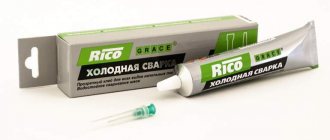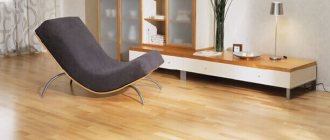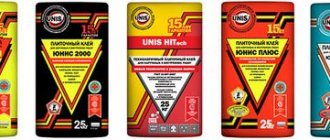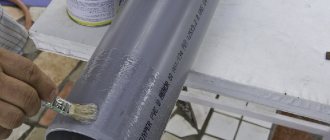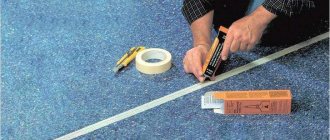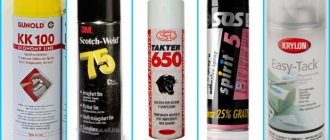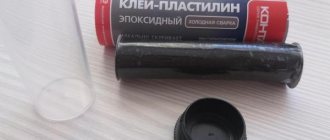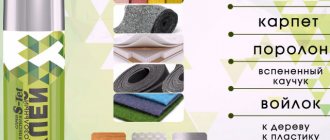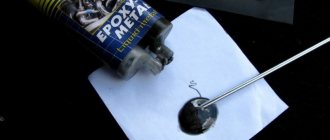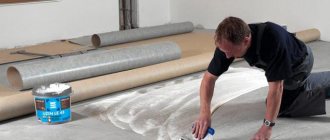When choosing linoleum, a problem often arises with dimensions, because you need to cut it so that it completely matches the length and width of the room.
Unfortunately, this is not always feasible, and buyers are forced to buy in sections, which are then joined together. One of the easiest ways to hide and secure a joint is cold welding .
This welding is a special glue, which, if applied to the edges of the linoleum, dissolves them a little, connecting them together. This way the seam becomes invisible , and if the entire technological process is carried out correctly, then only a specialist can see it.
How to choose cold welding?
Today, cold welding is presented in a wide range on the market, but there are also popular compositions that combine quality and inexpensive cost.
The key point when choosing cold welding is the purpose of gluing.
If repairs to an already finished coating are required, then stable compounds that contain PVC should be selected. The high content of PVC glue in the composition makes it possible to give strength to damaged areas. This glue will be harder than those brands that contain a solvent.
This option will be suitable even if the floor covering is cut unevenly.
Important! If the joint has a walking gap, then type A glue cannot be used
If optimal conditions are made for gluing and new sheets of linoleum are taken, then those options that contain a huge amount of solvent are used for gluing. Cold glue, which includes a huge amount of solvent, is highly elastic and, when dry, is practically invisible on the surface. True, the drying force will be lower, however, if the loads are not high this is not a problem. But the consumption in both cases will be similar.
Choosing a universal glue: what to look for?
When choosing cold welding, in addition to the brand and price, the following parameters are important:
Type of bonded surface.
There are universal adhesives for metal, linoleum and rubber, plastic and concrete. Moreover, the composition allows you to combine materials in any combination, combining into one whole, for example, concrete and wood, rubber and plastic, steel and glass.
Vibration resistance.
Cold metal welding withstands vibration loads, is resistant to aggressive environments and temperature changes. Successfully restores the tightness of radiators, tanks and fuel lines, oil pans and other elements.
Tear resistance.
Restoration of components operating under physical load using universal glue allows the connection to withstand forces of up to 200 N*m. Such welding is indispensable for emergency repair of a car suspension, as it will allow you to independently eliminate the malfunction (broken lever, rod, etc.) and get to a service center or garage without the help of a tow truck.
Heat resistance.
A special type of cold welding that can withstand heating up to 150-250˚C. It is successfully used to restore car mufflers, highways and heating system equipment.
Moisture resistance.
Adhesives of this group are impervious to moisture, and in some cases can be applied even to a wet surface, maintaining high adhesion to it.
Hardening time.
Since cold welding is often used for emergency repairs, setting time is important. The smaller it is, the better.
Cold welding for linoleum consumption
The consumption of joint material will depend on the thickness of the floor covering and the type of mixture used. The greater the thickness of the canvas and the gap between adjacent elements, the more glue will be used to fill it. Cold welding is sold in the form of tubes of 60-100 milliliters.
Titanium
This glue is sold in the form of a tube containing 100 milliliters of the composition. This clear or white mixture consists of a solvent and a base. To simplify application, a rod is inserted into the tube. The mixture hardens within 5 minutes from the moment of application, 100 milliliters is enough for 40-45 linear meters of seam. In addition to the usual composition, you can find T-type titanium on sale, which is used to fill gaps within 3-4 millimeters. You can see how to work with this glue in the video clip.
Axton
This Polish-made product is available in 60 milliliter tubes and is used to fill gaps within 3 millimeters. The mixture consumption is a fairly high tube per 5 meters of seam. The solution quickly thickens and shrinks, so it is applied in large doses.
Tarket
Tarket is a domestic product. A tube with a capacity of 50 milliliters is equipped with a thin metal needle. The composition is suitable for all types of linoleum; it can even be used to fill joints in the presence of uneven sections of the coating. The mixture consumption ranges from 10 to 20 linear meters per tube capacity. This product has received numerous positive reviews from consumers.
Methods of application
In order to glue strips using cold welding, you need to prepare the following tools:
- ruler;
- masking or double-sided tape;
- knife for cutting linoleum;
- substrate (fibreboard or an unnecessary strip of linoleum);
- Remedies.
You can connect the strips in several stages:
- Before you start gluing, you need to ensure that the edges of the coating are joined very tightly to each other . To do this, you need to trim the edges as follows: place them on the backing with an overlap of about 3 cm and trim both edges at the same time with a special knife. This way they will fit perfectly together and there will be a minimum distance between them.
- Next, you should protect the coating from accidental contact of welding with the surface. Apply masking tape to the edges .
- The linoleum should be fixed to the floor so that it cannot move while drying. You can choose several methods: using double-sided tape or special glue.
- Having glued and joined the material, we apply cold welding, making sure that there is no dust or dirt on the surface. Insert the tip of the spout as deep as possible into the gap; you can use special needle-shaped attachments. The glue should be approximately 5 mm higher than the masking tape.
Please note that if you accidentally dropped it on an unprotected surface, you should not wipe it off immediately, let the glue dry and then cut off the excess, so you will not damage the decorative layer. - Wait for complete drying (from 10 to 30 minutes)
- We remove the protective tape, carefully cut off the unnecessary welding layer with a knife, and smooth it out.
It is best to apply glue in small sections of 50 cm , and not entirely over the entire seam, so you can adjust the width of the seam at any time if it begins to diverge.
This video will tell you how to cold weld linoleum:
Types and characteristics of glue
How to glue linoleum to the floor? There are two main types of adhesives on sale - dispersion and reaction. The choice depends on the characteristics of the coating and the surface on which it is laid.
Dispersion adhesives
All products of this type are aqueous emulsions of polymer resins with the addition of various fillers and mineral particles. The benefits are obvious. Facilities:
- do not have an unpleasant odor;
- elastic;
- due to the water base, they are non-toxic and environmentally friendly;
- have excellent adhesion to the base.
The products are suitable for gluing linoleum to concrete floors. After hardening, they are not susceptible to moisture and perfectly seal joints and seams. The price is low: for example, the popular Homakoll glue costs 200-250 rubles/kg. Consumption per 1 sq. m is minimal, while many adhesives are frost-resistant.
Dispersants are divided into several groups:
- acrylate with acrylic resins are suitable for fastening to wood, concrete, mineral bases of semi-commercial and commercial linoleum;
- polyvinyl acetate, bustylates with the addition of latex, chalk are suitable for gluing thick PVC coating on a felt base to fiberboard, chipboard, concrete;
- compositions such as “Gumilax” based on rubber and latex resin are suitable for homogeneous material or foamed household coating on a natural basis;
- electrically conductive adhesives with a dispersion of conductive powder are used when laying antistatic linoleum;
- rubber mastics with bitumen resin are used for flooring on the first floors, in damp rooms. The rest are only suitable for rooms with humidity up to 55-60%.
Many dispersion adhesives cannot be used at low temperatures, so for a balcony, summer kitchen or other similar premises it is better to purchase a composition marked with frost resistance. It will not crumble even when frozen. When purchasing, be sure to check the GOST instructions, check the certificates of conformity and the date of issue. Expired adhesives partially lose their properties.
Reaction compositions
How to glue the coating reliably in difficult areas? For this purpose, reaction adhesives are used, for example universal and for carpet. They are called “cold welding” and are used for soldering seams and joints.
The components of the composition react with the material. After polymerization, a hard, moisture-resistant layer is formed between the base and the floor covering, resistant to tearing and shear. The bonding strength is very high, the joint can withstand shock loads and vibration.
Adhesives come in one-component and two-component types; the latter must be mixed before use.
Scope of use of reaction adhesives:
- offices and other commercial premises;
- rooms with high traffic - living rooms, hallways, kitchens;
- bathrooms;
- balconies;
- stairs, common corridors.
All adhesives can be divided into two groups depending on their composition:
- Polyurethane. Suitable for any type of linoleum, on all known substrates. They are often used in residential areas, as the unpleasant odor is weak and disappears quickly. The cost is high - from 400-500 rubles per kilogram.
- Epoxy. Consist of epoxy resin and hardener (two-component). Their strength is even higher, but they contain toxic components (solvents). Typically, such adhesives are used for outdoor work. Price – from 600 rubles per kilogram.
Most reactive adhesives have a severely reduced adhesion rating when used on dirty floors. Therefore, you should wash it thoroughly before work. Substrates made of mineral materials need a layer of primer - this will reduce glue consumption and improve adhesion
The disadvantages of adhesives include their rapid flammability - installation must be done with great care
Advantages and disadvantages
Welding is mainly used in residential premises due to the fact that it can be applied to already laid linoleum , does not require special skills, and dries quickly. also no problems when applied to a curly seam with many angles or wavy lines.
However, it is worth noting that difficulties may arise when applying welding to a multilayer material , the joint may be uneven and noticeable, gluing may not occur, so pay attention when purchasing glue for what materials it is intended .
Since welding consists of a variety of chemical solvents that have a strong, unpleasant odor, when gluing
it is necessary to ventilate the room where the work is being carried out .
You should wear a gauze bandage or any respirator to protect your respiratory system, and gloves will protect your hands.
When gluing, be careful and careful, as dripping cold welding onto the front side of the coating can ruin the appearance.
How to use cold welding
Construction adhesive, capable of reliably joining the floor covering, is a toxic substance, working with which is hazardous to health. Also, if used incorrectly, cold welding can corrode linoleum sheets, which will make the joint sloppy. You need to work with glue according to the instructions and following the following tips:
- When gluing sheets of flooring, you need to wear a special construction respirator and goggles to protect your eyes. Leave windows and doors in the room open. Ensure good air circulation.
- Select the composition of the adhesive carefully. Some types of joints and certain brands of linoleum require the use of welds with different percentages of glue and solvent.
- Do not leave the tube open for a long time, otherwise the glue will dry out. Putting a cap on the spout is not enough - it is better to insert a needle into it that fits the size of the hole or an awl.
- After gluing the seams, you should not try to speed up the drying process using hot welding or a simple hair dryer. This will reduce the volume of the adhesive and make the joint unreliable.
- While gluing, press the joints to the floor with an improvised press. This way you can avoid the appearance of air bubbles, which over time destroy the seam.
- After applying the adhesive, wipe the top of the flooring with a felt cloth to remove any excess PVC solvent. For the same purpose, masking tape is glued over the joints. Even with such protection, it is better to wipe the linoleum with felt.
Description and purpose
“Cold welding” is a simple and convenient method of connecting strips of linoleum to each other using an adhesive composition. This product operates on the principle of a solvent. The edges of linoleum melt when applied, as a result of which they are easily connected to other parts of the floor covering. “Cold welding” leaves thin seams that are almost invisible to the human eye. In terms of elasticity and strength, these seams are in no way inferior to the main linoleum sheet.
The purpose of “Cold Welding” is to reliably bond any type of linoleum, whether installing a new coating or repairing an old one. Benefits include:
- visually invisible monolithic seams;
- no need for professional skills and specialized equipment for work;
- low consumption of funds;
- minimal time investment;
- gluing complex joints of any configuration and thickness;
- democratic price.
Instructions for use
How to cold weld a linoleum joint? To carry out all the work correctly, you must strictly follow the instructions. It is described step by step below.
Seam formation
After purchasing the coating, its approximate fit, you need to form the optimal seam. To do this, lay both pieces as they will lie on the floor. In this case, the overlap should be 5 cm. Next, you will need a strong metal ruler and a pencil. Fasten both edges of the coating together with double-sided tape so that they do not move during cutting. Then markings are applied strictly in the middle, pressing the coating tightly with a ruler. Then they cut along the markings with a sharp knife to get even edges.
Cleaning the base and seam
Before gluing, you need to thoroughly clean the floor from dirt, remove the rest of the old coating, and vacuum it. Before work, all parts must be dried. Also, as preparation, you should protect the edges of the linoleum from damage. Cold welding contains aggressive components that can corrode the material. Glossy linoleum suffers especially badly. To avoid such troubles, you need to buy wide masking tape and cover the edges of both canvases with it, leaving a few millimeters for glue.
Cold welding application
Before work, you need to prepare a clean cloth or cotton swabs to remove excess and smudges of glue. There are two ways to apply the product:
- First. Using the tube nozzle, squeeze the glue onto both edges at once. At the junction, the linoleum will become liquid and the edges will melt.
- Second. Lubricate only one edge and place it on the floor. Then apply glue to the second edge and place it tightly next to the first. Level, smooth out the seam.
After a few hours you can walk on the floor without fear; the exact drying time is indicated in the instructions for the glue. When the linoleum is dry, you need to remove the masking tape.
https://youtube.com/watch?v=A5XFE6hCQX8
Removing excess glue
Often, excess composition flows out. You should not touch them while welding the edges; this can cause the floor covering to peel off and the seam to break. Dried cold welding is removed in 2 steps. Since a fresh seam is elastic, strong tension and cutting may leave a crater. It is better to first cut off the excess that sticks out on the surface, and after a day to finish the job. You can do all the work yourself, without the help of specialists. Installing a weld is a painstaking task, but quite doable!
What is cool welding of linoleum
To fasten this material, a special glue is often used, it is called cold welding.
This product has good characteristics for gluing different materials.
The glue has a “cool weld”
", the adhesive qualities are much higher than those of other adhesives and because of this, professionals prefer to use it in their work.
This glue is used for gluing and repairing linoleum.
A big advantage of cold welding is the maximum connection of one surface to the second. Thanks to this, a large number of loads can be easily transferred. The use of this glue is not considered difficult, and it practically does not stand out from simple gluing, but the result will be high. For skirting boards and other decorative elements made of polyvinyl chloride, the same glue is used.
This composition is not afraid of moisture, sub-zero temperatures and other bad factors. This means that gluing linoleum does not require any special conditions, and the properties of the glue do not change when used.
How to choose?
- Decide on the purpose. The welding must be appropriate for the material being exposed. Otherwise problems may arise. As a last resort, it is possible to use glue with a metal core.
- Permissible temperatures. If the part is exposed to prolonged heat or is under an open flame, it is necessary to purchase appropriate compounds.
- How quickly it dries. If there is a need for urgent repairs, it is recommended to have 2 types on hand. First use welding and allow it to dry for an hour. This will help solve the problem. But since the layer does not have high strength, apply a long-drying compound (24 hours) on top.
- How to remove. To do this, use solvents or acetylene. The liquid is carefully treated with the frozen substance and lifted by the edge. This can damage the finish, especially wood and glass. Therefore, it is necessary to be extremely careful when using cold welding.
What it is?
Linoleum is an artificial material that is produced on the basis of various chemical compounds. The joining of sheets creates a small gap, which is not aesthetically pleasing or beautiful. To obtain a solid seam, the cold welding method is used.
This approach involves the use of a special glue that connects the linoleum sheets into a single whole. When exposed to a substance, a chemical reaction occurs that makes the material liquid. During this short time, the joints have time to set and form a strong connection. Cold welding is a relatively simple joining method that can be performed even without experience and a special tool for soldering (soldering iron, etc.).
The properties of the glue are such that they allow you to work with joints of different widths. The resulting joint also has plasticity and its characteristics are practically no different from those of linoleum.
Glue composition
There is a wide variety of cold welding products on store shelves, but despite the large number of manufacturers, the composition remains the same, only the ratio of components may differ:
The solvent is tetrahydrofuran, the substance requires the presence of chlorine in the composition. This component acts on linoleum containing polyvinyl chloride and dissolves it. The glue has practically no effect on other types of material.
Filler – liquid PVC.
The best adhesives for PVC materials
Homakoll
Gluing the seams and gluing the back side to the base is done with different compounds. Why this was implemented is clear from the above - in this case, you need to glue the PVC material to a wooden, composite or concrete base.
Some of the best options are the following basics:
- Homakoll is a French adhesive composition based on a polymer dispersion, which in practice firmly connects the linoleum surface to any base (requires drying on the base to eliminate waves), provides excellent quality of gluing seams.
- BauGut is a similar gluing material made in Germany, but is made on an acrylic base with fillers, and therefore has a more reasonable price. Provides fairly strong joint connections that do not come off during the entire service life in rooms with light loads.
- Axton - a very good composition with appropriate reviews for gluing PVC sheets to the base, does not give waves when drying, polymer;
- Tarkett - the advantage of this composition is that the manufacturer produces glued floor coverings and, accordingly, guarantees the quality of installation with its materials. Tarkett produces a composition for gluing the base and joints on a polymer basis, ensuring a tight, inextricable connection.
- Tytan - we are also talking about welding seams, but the principle is slightly different. The composition is a solvent and is more suitable for installation without a gap, otherwise the consumption will be quite large and not economical.
- Werner Muller is the progenitor of technology. This brand offers two adhesive options: for gluing without a gap between the sheets (type A) and with a gap, type C. With a gap, type C provides a sealed seam with a gap of up to 4 mm. Tarkett also produces a similar composition. Type C is considered a universal option for do-it-yourself installation when it is impossible to guarantee a perfect cut.
Glue selection
It is necessary to select a product not only depending on the type of coating. The type of base must be taken into account. Some adhesives are universal, while others cannot be used to glue decking to wood (plywood, boards). If you want to save money when connecting flooring to a wooden floor, you can buy PVA.
With concrete screed it is more difficult - you will have to purchase a professional composition. When you come across a popular brand on the counter, you need to carefully read the instructions. It always indicates what the glue is suitable for. Next, a calculator will be useful to calculate the consumption of materials and, accordingly, the cost of repairs and choose a product that suits your pocket.
Advantages of Titan
- This brand has some of the highest performance indicators, which ensure the possibility of use even in difficult operating conditions;
- The adhesive can be used as a high temperature cold weld for metal;
- Work can be carried out not only with metal products, but also with other materials, while maintaining all the qualities of resistance;
- Delivery is carried out in insulated packaging, which ensures reliable safety until opening;
- Ease of use, regardless of user experience;
- High level of adhesion;
- Hardening of the material within 5 minutes;
- The supply volume is quite large, so one pack can be enough for several uses.
Review of manufacturers
The market for cold welding for linoleum is very diverse, as it is produced by many manufacturers. This is due to the fact that this adhesive is universal and suitable for almost all PVC products. Among the variety of models, several main brands of these products should be highlighted:
- WernerMuller. A German brand under which all types of cold welding are produced. The quality of the material meets all international standards. Experts note that the substance forms a high-quality and durable seam. The average glue consumption is approximately 44 g per 20-25 linear meters.
- Tarkett. Another German brand, which, according to reviews, is even slightly superior to the previously reviewed products. The glue has universal characteristics and forms an almost invisible seam.
- "Homakol". Domestic glue, which is used mainly for gluing PVC boards and commercial linoleum. Material consumption is approximately equal to the previously indicated indicators.
- Rico. This brand of glue does not contain tetrahydrofuran, which is toxic to humans. Instead, special polyurethane foam compounds or artificial rubber are used here. Soldering with these substances is not very different from the options where classic glue is used. At the same time, the cost of production is somewhat lower and there is no strong toxic fumes.
- "Second" and Sintex. Relatively cheap solutions made in Russia and Spain. The consumption of this material has already reached 45 g per 50 linear meters of seam.
General information
Classification of linoleum
Before introducing you to welding methods, it is important to find out and decide which type of linoleum you will purchase. The welding method and glue required to connect the flooring sheets will depend on what kind of linoleum you will install on the floor.
Linoleums are classified according to various criteria . One of the simplest divisions is the presence of a substrate for the floor covering. There are basic and baseless linoleums. Baseless - very thin - only 1.6mm thick. They are short-lived and require a perfectly level subfloor. Any recesses and potholes will be noticeable on this type of linoleum. There may be traces left from the furniture, and it can quickly tear. The price of such linoleum is small. Recently, cheap flooring is rarely purchased because it wears out quickly.
Basic linoleum is divided into 3 classes: warm (felt) base, foam base and multi-layer. The basis of the first class is synthetic or natural felt. It fits perfectly into a children's room and hall, because the feet are warm and it is comfortable for children to play and run on the warm floor. The thickness of this linoleum is 5mm. The top polymer layer (such linoleum consists of two layers) takes up only 1.5 mm. Therefore, such flooring is afraid of water and is not intended for bathrooms. Foam-based linoleum has a thickness of 2-3.5 mm. It is moisture resistant and not afraid of chemicals. Therefore, it can be laid anywhere: in rooms, bathrooms, kitchens.
Multilayer linoleum has different substrates: jute, polyester, foamed PVC. It is applied to a fiberglass base coated with polyvinyl chloride. Fiberglass protects linoleum from deformation. A pattern is visible on the front layer, which covers the protective layer. To increase the wear resistance of the protective layer, a polyurethane layer is applied. Multilayer linoleum not only has increased wear resistance, but also heat-insulating and sound-proofing properties. It is not afraid of moisture, so it can be placed not only in rooms, but also in the kitchen, hallway, and bath.
It is worth paying attention to the joints in the bathroom, because the room has high humidity. The joints should be joined by hot welding or special adhesives should be used for cold welding.
Linoleum is also classified by material. Depending on the material, there are natural, rubber, PVC, nitrocellulose, and hyphthalic linoleums. The best ones are natural. They consist of tree resin, linseed oil, lime, and cork flour. It has antiseptic properties, is not afraid of microorganisms, and is susceptible to rot and mold. It does not absorb grease, does not fade or crack, so it can be used in the kitchen and will last a long time.
Rubber linoleum has a special filler and rubber in the top layer. Its base is crushed rubber or bitumen. It is moisture resistant and elastic. Linoleum made from polyvinyl chloride is available with or without a base. Its elasticity, attractive appearance, and affordable price have made this type of linoleum popular among buyers. But it also has serious disadvantages: a specific smell that does not disappear for a long time, it cannot withstand low temperatures, it can crack and even burst.
Hyphthalic linoleums are not as elastic as PVC linoleum. But they have high sound-proofing and heat-insulating properties. Ideal for apartments with increased audibility. Nitrocellulose linoleums are elastic, moisture-resistant, and have a specific shine. But they are fire hazards.
Linoleums also differ in place of application. It depends on the degree of wear resistance of the materials. There are household, semi-commercial and commercial linoleum. Household linoleum has a thickness of no more than 4mm. It is beautiful, elastic, but wears out quickly and can break if handled carelessly.
When installing household linoleum, a cold welding method is used. Semi-commercial linoleum is designed for premises with average traffic: offices, hotels, but is successfully used in houses and apartments. It has an additional protective layer of 0.7mm. The wear resistance of semi-commercial linoleum is much higher than that of household linoleum.
Commercial linoleum is intended for high-traffic areas: large offices, schools, hospitals, museums, shops. It is made on the basis of foamed PVC, which has increased resistance to mechanical stress and temperature changes. For commercial linoleum, you can use cold welding T adhesive, as well as hot welding.
When and why is this needed?
Linoleum is a practical, convenient and easy-to-install material. It is usually made from polyvinyl chloride, but there are other types of material. The coating can be of any color, which allows you to match it to any interior style.
Structure of semi-commercial linoleum
The material has several classifications, the main one of which divides all its types into two types - household and commercial. The first has a small thickness and is used to decorate floors in the apartment. The second is more durable and reliable, thick enough and can be installed in industrial enterprises, high-traffic offices, shopping centers, etc. Some categories of commercial linoleum are suitable for installation at home.
Types of linoleum
Linoleum
Various sizes of rolls allow them to cover floors in rooms of different sizes - from tiny bathrooms to spacious halls. Particular chic is if the material is laid without noticeable joints. Then it is possible to achieve a monolithic and even coating without the notorious thresholds at the joints of the canvases, without visible nail heads. It is in this case that you need to know how to properly glue individual linoleum sheets together.
What are the sizes of linoleum
Also, gluing the material may be necessary if the coating has been torn due to careless use. This can happen as a result of cuts from sharp objects or when heavy furniture is carelessly dragged over it.
In this case, the skill of gluing material can also come in handy.
In the photo - repair using a pencil
Damaged linoleum
Features of application
Connecting seams by welding is an ideal option for installing flooring at home if you want to end up with a flat floor surface with minimal visibility of the joints. Like any method, it has its advantages and disadvantages.
Knowing them, you can determine which cold welding to choose for linoleum and whether it is worth doing it at all. Maybe hot welding would be better in this case.
Pros:
- high-quality results in a short period of time;
- no additional tools or equipment required. Manufacturers usually supply everything necessary along with the glue;
- low cost;
Minuses:
- The glue contains toxic substances. Personal protective equipment is required;
- suitable only for single-layer linoleum;
- if there is insulation material under the coating, cold welding is also not recommended.
Cold welding of linoleum is a very simple joining method
The best glue for welding linoleum
A high-quality adhesive can tightly connect a seam of any complexity. Good cold welding for linoleum should have a short drying time, high joint density without the need for additional tools. High-quality glue can be purchased from the following manufacturers:
- Axton;
- Linocol;
- Sintex;
- Tarkett;
- Homokoll;
- Forbo.
Read on Stellanews: How to remove fungus in the cellar
Type A
Werner Muller
Cold welding is suitable for welding the seams of new PVC flooring. The consumption of the active substance is 44 grams per 20 meters of joint. The composition can be used for gluing overlapping sheets. Net weight of liquid inside the tube is 44 g. Price is 475 rubles.
Main advantages:
- Sets quickly.
- Can connect uneven joints.
Minuses:
- Not able to glue old coating.
Tytan 100 ml
Universal adhesive for cold welding of PVC products. The average consumption of the substance is 100 ml per 45-50 m of seam. Working time after exposure to air is 10-15 minutes. Drying time: 30 minutes. Complete polymerization occurs within a day at 20° C. Price – 240 rubles.
Main advantages:
- Versatility. The substance is suitable for working with any PVC products.
- Low price with good quality.
Minuses:
- Short working hours.
Type C
Werner Müller type C
The main purpose of cold welding is loosely cut joints. The composition can glue any PVC coating.
The maximum permissible gap between the sheets to be joined is 3-4 mm.
The cost of one tube is 534 rubles. Volume – 30 ml. Time until hardening after application is 10-15 minutes.
Main advantages:
- You can buy directly from the manufacturer.
- Fast hardening.
- It softens the sheet well.
Minuses:
- None.
Tarkett Werner Muller type C
The colorless substance can join loosely cut PVC coating joints. It has a thick consistency, due to which it fills the seam well, eliminating the appearance of air bubbles. Consumption – 42 g per 15 meters. It is characterized by increased frost resistance. Sets in 30-35 minutes. Complete polymerization – a day after application. Price – 610 rub.
Main advantages:
- You can buy directly from the manufacturer.
- Able to quickly glue uneven seams.
- Leaves no residue when applied to the top of the coating.
Minuses:
- High toxicity of fumes.
Type T
Tarkett Werner Muller type T
Main advantages:
- The strength of the created seam.
- Ability to work at temperatures up to 16° C.
Minuses:
- High consumption - 42 grams per 7 meters.
Tarkett cold welding agent Type T
The product can glue the seams of linoleum based on felt, polyester and PVC. The weight of the active substance is 45 grams. Consumption – 45 g per 7 meters. Can work at low temperatures (up to 12°C) outdoors. The kit includes a special T-shaped leveling attachment.
Main advantages:
- Versatility.
- High-quality gluing of many types of materials.
Minuses:
- Big expense.
- Consistency too thick.
The best cold welding adhesives in the mid-price segment
PERMATEX Cold Weld 14600 56 g
Adhesive for parts subject to increased load. A universal solution for interaction with ferrous and non-ferrous metals. After polymerization, it forms a hard layer that can be drilled, filed and painted. Thanks to this, it is possible to restore the original appearance.
PERMATEX Cold Weld 14600 56 g
Advantages:
- maximum load for steel 3000 PSI;
- mechanical processing of the seam;
- no need to heat to accelerate polymerization;
- gap filling;
- fire resistant.
Flaws:
- Due to the high speed of hardening, work must be carried out as quickly as possible.
TANGIT EPOXY-LOCK
A new product from the German company Henkel, which needs no introduction. Its products are well known in all corners of the globe. The universal Epoxy-lock flawlessly copes with the task, firmly connecting any type of material. Works well when sealing minor leaks in pipes and heaters. The dried seam can be sanded and further painted to restore its original appearance.
TANGIT EPOXY-LOCK
Advantages:
- for underwater work;
- temperature range from -30 to +150°C;
- does not contain solvents;
- easy application;
- high strength.
Flaws:
- does not glue polyethylene, polypropylene and Teflon;
- takes a long time to set.
Kafuter AB
A universal solution for any type of surface, aimed at home use. A permanent member of the portable repair kit. Distributed in two tubes marked A, B. Initial drying within 1 hour. The components are mixed in proportions 1:1.
Kafuter AB
Advantages:
- universal purpose;
- sealed packaging;
- The optimum ratio of price and quality.
Flaws:
- initially emits a pungent odor.
First about technology
Manufacturers delight us with figurative names of technologies. This also happens with Cold Welding technology, also known as Fast Steel, Liquid Nails and others. This is a figurative presentation of technology that ensures a strong connection of surfaces when gluing.
Cold welding
If we talk directly about welding the same pipes, then we are talking about a deforming effect on the metal, as a result of which new interatomic bonds are established.
There is nothing like this in the adhesives offered on the market. The technology is partially repeated by a two-component epoxy resin, which comes with a metal powder hardener.
Indeed, the connection turns out to be very strong, and this particular method of gluing can be found in a number of manufacturers, but not in all.
In relation to linoleum, the gluing principle is implemented most closely to welding. When gluing, molecular bonds are established, if not interatomic ones. Moreover, different brands implement this differently. The principle is to connect PVC materials using PVC glue, which is epoxy resin with a hardener.
As a result, for example, if you glue linoleum joint to joint, the distance between the edges is filled with a material similar to the coating - PVC, which at the molecular level binds to two separate parts of the material. As a result, such a connection will be inextricable and can be used indefinitely until the coating itself wears out.
The principle of gluing, we glue PVC to PVC to ensure molecular bonds, is implemented in all the best means for these purposes. We will talk about them.
Top 1. "Second" 403-203
Rating (2021): 4.45
97 reviews from resources taken into account: Yandex.Market, Ozone
The most universal cold welding Secunda glue is the most universal in the rating. With its help you can connect the largest number of materials in any combination - from linoleum and metals to glass and wood.
- Characteristics
Average price: 305 rub.
- Country: Russia (manufactured in China)
- Weight: 75 g
- Curing time: 6 hours
- Temperature resistance: 0…+60˚C
- Number of components: 1
Construction adhesive "Secunda" 403-203 does an excellent job of joining PVC materials of different densities. Users note an invisible and ultra-strong seam when working with water pipes, plexiglass, linoleum, etc. Using this cold welding, you can fill chips and cracks in plastic, wood, glass, metal and stone. Resistance to moisture allows the product to be used for gluing parts in contact with water. The composition gains maximum strength after complete drying for 6 hours. If the instructions for use are not followed, the surface of the linoleum may be corroded.
Advantages and disadvantages
- Glues well
- Large volume
- No needle to apply
- Requires careful use
- Takes a long time to set
See also:
- 10 Best Shoe Adhesives
to the beginning of the rating
Dispersion glue
This adhesive consists of acrylic or cellulose-glycolic acid mixed with special additives - chalk, latex, and water acts as a solvent. They do not contain dangerous volatile toxic substances, have no pungent odor and are suitable for interior work.
Dispersion adhesive is mainly presented in 3 varieties:
- Bustilate is a widely used universal adhesive based on chalk, latex and carboxymethylcellulose. Recommended for linoleums with felt (fleecy) base. There is an opinion that after using this glue, permanent stains appear on the PVC coating.
- Acrylic adhesive is made from thermoplastic resins, has a high degree of viscosity and is optimally suited for household heterogeneous and homogeneous floor coverings (fibre, jute or with a two-layer synthetic base).
- Gumilax is a latex and rubber adhesive for laying natural linoleum and artificial coverings on a fabric or felt basis.
The main and only disadvantage of dispersion mixtures is the complete or partial loss of properties at low temperatures (less than 15 °C) and high humidity (more than 60%). The frozen and then thawed composition is not restored and loses its elasticity. However, there are also frost-resistant water-dispersion adhesives for linoleum, such as Khomakol 268 or Forbo 418.
Dispersion adhesive Forbo 418 for linoleum.
Laying linoleum
After the measurements have been taken, the fabric is cut along the edges, leaving allowances for adjustment. If the wall is smooth, they begin to glue the PVC coating closely or overlapping, so that they can trim it later.
In the photo: laying and cutting linoleum with your own hands.
When laying linoleum from two strips, do it perpendicular to the window so that the seam is lost in the direction of the light. Then the floor covering will seem monolithic. Linoleum should be joined correctly so that the pattern on one piece matches the image on the other. They begin to roll out the second sheet from the joining point, overlapping it onto the previously spread sheet, this subsequently allows for an even and neat cut to be made.
Types of welding
Linoleum adhesive comes in several varieties. You can find several mixture options on the market with different compositions and methods of use. The following types exist:
- Type A. Sold in liquid form because it contains a lot of solvent. The glue perfectly dissolves the material and binds it. But the mixture is not recommended if there is a gap of more than 2 mm between the parts that are joined. In this case, it will not be possible to make a strong and stable connection; it will quickly break. But type A allows you to make the seams almost invisible and very neat. The connection can withstand heavy loads.
This option is suitable for new coating. The ends are very even and the joint is tight.
- Type C. Thick glue, contains a lot of filler. The composition contains mastic made from waterproof binders, and this makes the connection elastic. This type is suitable for gaps up to 4mm. Type C is often used both to create joints and to repair small defects on an old product.
- Type T. Used quite rarely. The reason is that it is suitable for multi-pack linoleums made from polyester or PVC. Type T is more suitable for material with semi-commercial purposes.
Additional tips and tricks
- It is necessary to ensure proper air circulation by leaving the doors and windows of the room open. Work must be carried out exclusively in protective glasses and a respirator.
- Do not leave the tube with the product open for a long time. It is not enough to put a cap on the spout; in addition, you should insert an awl or needle of a suitable size into it.
- For coatings on a thick felt or polyester base, as well as multi-layer fabrics, highly meltable T-type adhesives are used.
Decoding the icons on clothes Test for cleanliness in your home Laundry weight calculator Ask a question to an expert
Share link:
Subscribe to our Social networks
Types of gluing
Currently, two gluing options are used:
Cold welding for linoleum.
This is when each part of the coating is laid out according to size in its place and glued. Then they press and glue, with all seriousness, the next line to the previous one in the same way. And so they do until they cover the entire floor surface.
In these cases, colorless glue is used, this makes it possible to make the seams invisible.
Hot welding.
Of course, this is not traditional metal welding, but it is somewhat similar. This method is usually used on an industrial scale. During hot welding, temperature treatment occurs on the edges of linoleum; it occurs at a temperature of four hundred degrees. During processing, a cord is sewn into the middle of the sheet and thanks to this, the materials are held together. As soon as the cord is inserted, the seam is leveled so that it is not visible.
Types of Cold Welding
Cold welding for linoleum is done in various types, which are distinguished by their qualities and method of application.
And so there are three main types:
Cool welding for linoleum type A - has a liquid consistency and contains a solvent, in large quantities, which is needed for processing the edges.
This glue is not used for cracks larger than 2 millimeters.
The main feature of this material is the creation of a beautiful and invisible connection.
This glue also creates a strong and reliable connection, but it is not recommended to use it for repairs.
Cool welding for linoleum type C is an adhesive for cold welding of linoleum, it has a huge amount of PVC material, in other words, it contains less solvent.
Due to the fact that the adhesive composition is rich and juicy, it will easily bridge gaps larger than 2 millimeters.
Cold welding is used to seal cracks that have formed on the old coating. The size of the gaps should not be more than four millimeters.
When the glue dries it leaves a tight, durable seam.
Cool welding for linoleum type T. This type is made for professional use.
This composition is excellent for use with linoleums, which are multicomponent and made on the basis of PVC and polyester.
After applying the glue, the seam is reliable and elastic.
A characteristic feature of the following brands is considered to be a low melting point, however, this option does not require high values, which are found in cold welding for metal.
Consumption
Cold welding consumption depends on three main factors:
- Skill of the worker - an experienced person applies a minimal amount of glue to the seam, which minimizes the amount of waste. If the installation is being done for the first time, and your hand is not yet full, more solution may be needed than necessary.
- Blade thickness - the smaller the indicator, the lower the welding consumption. Thick linoleum is rarely used for domestic purposes.
- Cold welding type is the most popular A type, up to 60 ml is consumed per 25 linear meters. Type C glue has a higher consumption: up to 90 ml for the same 25 linear meters. Some manufacturers indicate consumption in grams. This makes the choice easier.
Criterias of choice
When choosing an adhesive for fixing a floor covering, it is worth considering a number of criteria.
Subfloor type
First of all, you should focus on the type of subfloor. Depending on this, one or another composition is chosen.
Absorbent
This category includes a cement or concrete base. Absorbent coatings also include chipboard, fibreboard, OSB, plywood flooring or solid wood. For such substrates, it is recommended to choose a water-soluble composition.
It is worth considering some features. Board materials can become deformed from excess moisture. Therefore, thick formulations with a minimum of water are suitable for them. Any adhesive will work for concrete.
Non-absorbent
This category includes floors that are lined with natural stone, tiles or porcelain stoneware. In this case, water-soluble compounds will not have an effect, since there is no space for moisture to escape. In this situation, reaction adhesives are suitable
When using them, it is important to follow safety rules - use protective gloves and a mask. Room ventilation is important
Linoleum can be based on different components. There are homogeneous and heterogeneous compositions. Often the coating is made of PVC. It is worth choosing glue taking into account the manufacturer’s recommendations. Gummilak is suitable for foam coating. It provides excellent adhesion and helps avoid damage to the coating. For commercial linoleum with a complex composition, you will need a special substance.
Peculiarities
In terms of its chemical composition, the glue for welding joints is a kind of solvent, which first transforms the edges of both panels into a liquid state, then the joint gradually hardens and is firmly “welded.” The resulting seam is almost invisible, and the coating in the treated areas becomes monolithic and wear-resistant.
Important! The composition of the cold welding adhesive used for linoleum is toxic, so you should carry out the work with gloves and a mask with the windows open.
